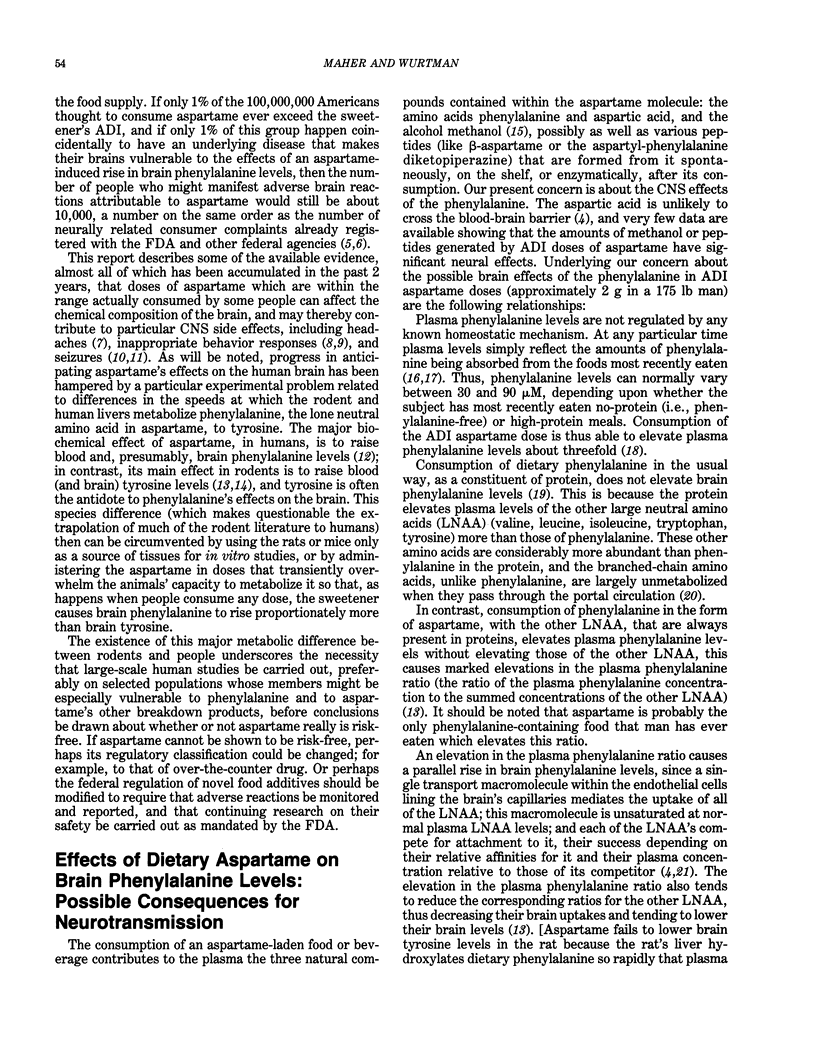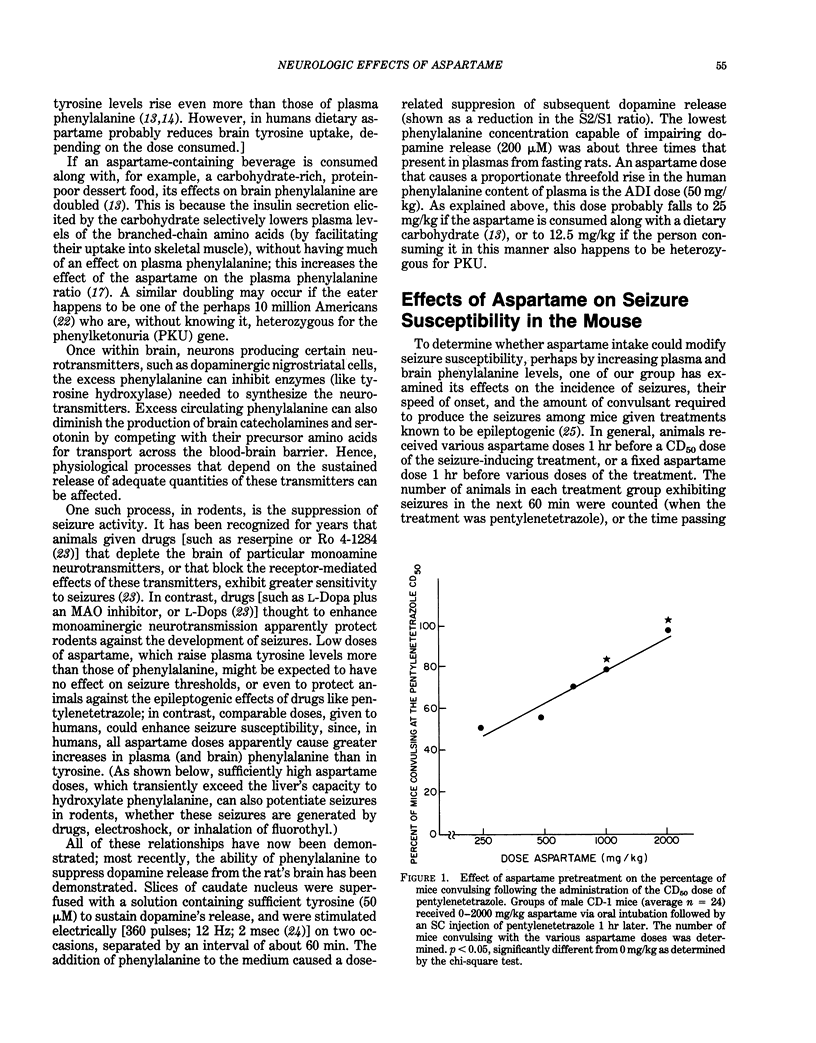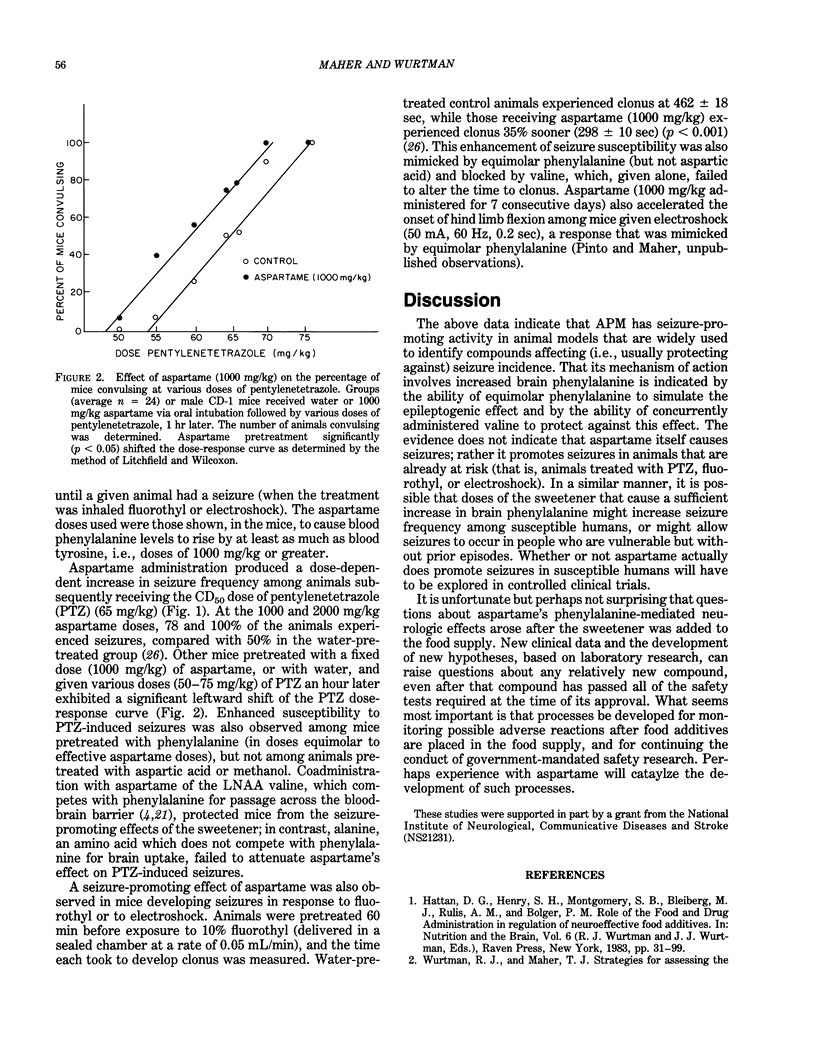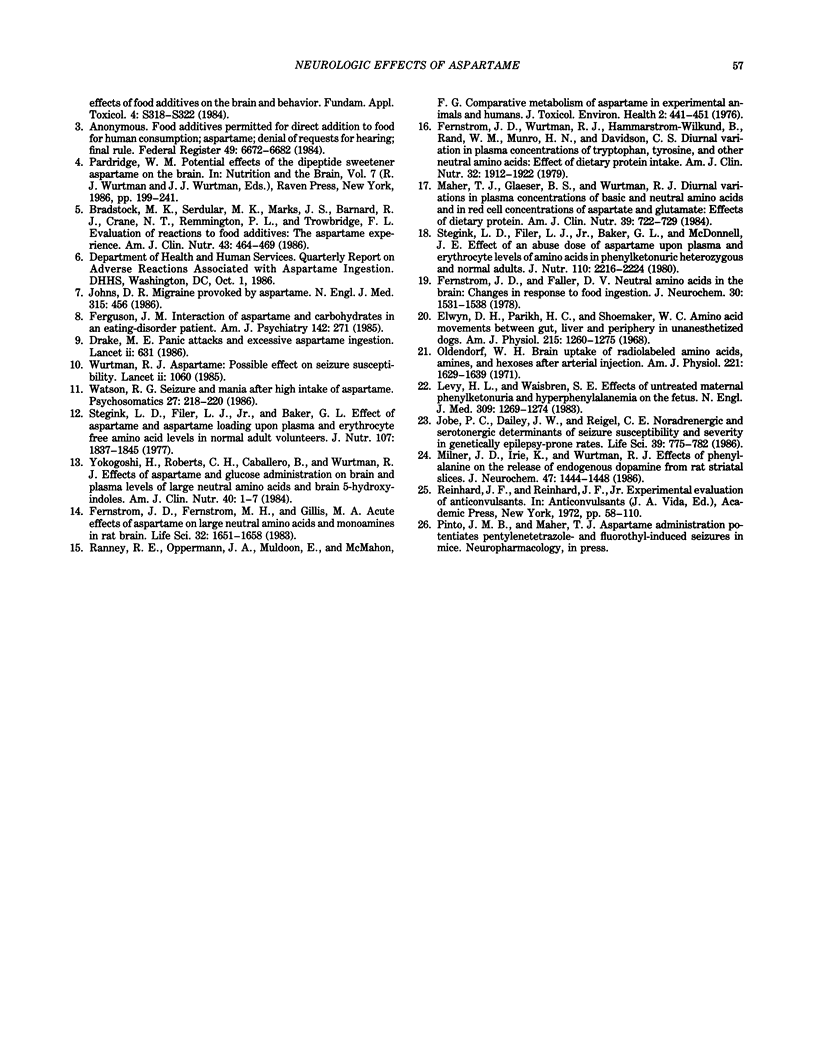Abstract
The artificial sweetener aspartame (L-aspartyl-L-phenylalanyl-methyl ester), is consumed, primarily in beverages, by a very large number of Americans, causing significant elevations in plasma and, probably, brain phenylalanine levels. Anecdotal reports suggest that some people suffer neurologic or behavioral reactions in association with aspartame consumption. Since phenylalanine can be neurotoxic and can affect the synthesis of inhibitory monoamine neurotransmitters, the phenylalanine in aspartame could conceiveably mediate neurologic effects. If mice are given aspartame in doses that elevate plasma phenylalanine levels more than those of tyrosine (which probably occurs after any aspartame dose in humans), the frequency of seizures following the administration of an epileptogenic drug, pentylenetetrazole, is enhanced. This effect is simulated by equimolar phenylalanine and blocked by concurrent administration of valine, which blocks phenylalanine's entry into the brain. Aspartame also potentiates the induction of seizures by inhaled fluorothyl or by electroconvulsive shock. Perhaps regulations concerning the sale of food additives should be modified to require the reporting of adverse reactions and the continuing conduct of mandated safety research.
Full text
PDF




Selected References
These references are in PubMed. This may not be the complete list of references from this article.
- Bradstock M. K., Serdula M. K., Marks J. S., Barnard R. J., Crane N. T., Remington P. L., Trowbridge F. L. Evaluation of reactions to food additives: the aspartame experience. Am J Clin Nutr. 1986 Mar;43(3):464–469. doi: 10.1093/ajcn/43.3.464. [DOI] [PubMed] [Google Scholar]
- Drake M. E. Panic attacks and excessive aspartame ingestion. Lancet. 1986 Sep 13;2(8507):631–631. doi: 10.1016/s0140-6736(86)92456-6. [DOI] [PubMed] [Google Scholar]
- Elwyn D. H., Parikh H. C., Shoemaker W. C. Amino acid movements between gut, liver, and periphery in unanesthetized dogs. Am J Physiol. 1968 Nov;215(5):1260–1275. doi: 10.1152/ajplegacy.1968.215.5.1260. [DOI] [PubMed] [Google Scholar]
- Ferguson J. M. Interaction of aspartame and carbohydrates in an eating-disordered patient. Am J Psychiatry. 1985 Feb;142(2):271–271. doi: 10.1176/ajp.142.2.271a. [DOI] [PubMed] [Google Scholar]
- Fernstrom J. D., Faller D. V. Neutral amino acids in the brain: changes in response to food ingestion. J Neurochem. 1978 Jun;30(6):1531–1538. doi: 10.1111/j.1471-4159.1978.tb10489.x. [DOI] [PubMed] [Google Scholar]
- Fernstrom J. D., Fernstrom M. H., Gillis M. A. Acute effects of aspartame on large neutral amino acids and monoamines in rat brain. Life Sci. 1983 Apr 4;32(14):1651–1658. doi: 10.1016/0024-3205(83)90873-1. [DOI] [PubMed] [Google Scholar]
- Fernstrom J. D., Wurtman R. J., Hammarstrom-Wiklund B., Rand W. M., Munro H. N., Davidson C. S. Diurnal variations in plasma concentrations of tryptophan, tryosine, and other neutral amino acids: effect of dietary protein intake. Am J Clin Nutr. 1979 Sep;32(9):1912–1922. doi: 10.1093/ajcn/32.9.1912. [DOI] [PubMed] [Google Scholar]
- Jobe P. C., Dailey J. W., Reigel C. E. Noradrenergic and serotonergic determinants of seizure susceptibility and severity in genetically epilepsy-prone rats. Life Sci. 1986 Sep 1;39(9):775–782. doi: 10.1016/0024-3205(86)90455-8. [DOI] [PubMed] [Google Scholar]
- Johns D. R. Migraine provoked by aspartame. N Engl J Med. 1986 Aug 14;315(7):456–456. [PubMed] [Google Scholar]
- Levy H. L., Waisbren S. E. Effects of untreated maternal phenylketonuria and hyperphenylalaninemia on the fetus. N Engl J Med. 1983 Nov 24;309(21):1269–1274. doi: 10.1056/NEJM198311243092101. [DOI] [PubMed] [Google Scholar]
- Maher T. J., Glaeser B. S., Wurtman R. J. Diurnal variations in plasma concentrations of basic and neutral amino acids and in red cell concentrations of aspartate and glutamate: effects of dietary protein intake. Am J Clin Nutr. 1984 May;39(5):722–729. doi: 10.1093/ajcn/39.5.722. [DOI] [PubMed] [Google Scholar]
- Milner J. D., Irie K., Wurtman R. J. Effects of phenylalanine on the release of endogenous dopamine from rat striatal slices. J Neurochem. 1986 Nov;47(5):1444–1448. doi: 10.1111/j.1471-4159.1986.tb00777.x. [DOI] [PubMed] [Google Scholar]
- Oldendorf W. H. Brain uptake of radiolabeled amino acids, amines, and hexoses after arterial injection. Am J Physiol. 1971 Dec;221(6):1629–1639. doi: 10.1152/ajplegacy.1971.221.6.1629. [DOI] [PubMed] [Google Scholar]
- Ranney R. E., Oppermann J. A., Muldoon E., McMahon F. G. Comparative metabolism of aspartame in experimental animals and humans. J Toxicol Environ Health. 1976 Nov;2(2):441–451. doi: 10.1080/15287397609529445. [DOI] [PubMed] [Google Scholar]
- Stegink L. D., Filer L. J., Jr, Baker G. L. Effect of aspartame and aspartate loading upon plasma and erythrocyte free amino acid levels in normal adult volunteers. J Nutr. 1977 Oct;107(10):1837–1845. doi: 10.1093/jn/107.10.1837. [DOI] [PubMed] [Google Scholar]
- Stegink L. D., Filer L. J., Jr, Baker G. L., McDonnell J. E. Effect of an abuse dose of aspartame upon plasma and erythrocyte levels of amino acids in phenylketonuric heterozygous and normal adults. J Nutr. 1980 Nov;110(11):2216–2224. doi: 10.1093/jn/110.11.2216. [DOI] [PubMed] [Google Scholar]
- Walton R. G. Seizure and mania after high intake of aspartame. Psychosomatics. 1986 Mar;27(3):218–220. doi: 10.1016/S0033-3182(86)72715-1. [DOI] [PubMed] [Google Scholar]
- Wurtman R. J. Aspartame: possible effect on seizure susceptibility. Lancet. 1985 Nov 9;2(8463):1060–1060. doi: 10.1016/s0140-6736(85)90920-1. [DOI] [PubMed] [Google Scholar]
- Wurtman R. J., Maher T. J. Strategies for assessing the effects of food additives on the brain and behavior. Fundam Appl Toxicol. 1984 Jun;4(3 Pt 2):S318–S322. doi: 10.1016/0272-0590(84)90258-6. [DOI] [PubMed] [Google Scholar]


